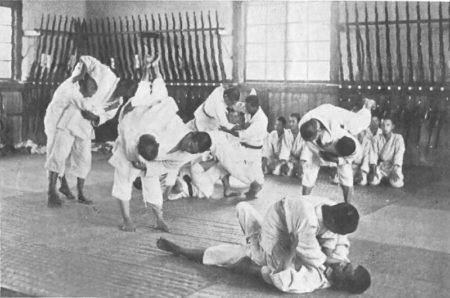Choque, Volume 1
I recently read Choque: The Untold Story of Jiu-Jitsu in Brazil, Volume 1 by Roberto Pedreira (Amazon affiliate link), which tells an alternate story of BJJ’s beginnings than we have been told by in various interviews with members of the Gracie Family. “Choque” translates to “shocking” in Brazilian Portuguese. While Pedreira exhaustively researches and cites primary sources, mostly Brazilian newspapers, he draws conclusions to support a generally anti-Gracie narrative.
Pedreira does a good job explaining that what became Brazilian Jiu-Jitsu was originally Kodokan Judo. Mitsuya Maeda and the other Japanese teachers in Brazil were all black belts from the Kodokan. We also learn early on that a number of Brazilians became black belts under these teachers and were teaching “Jiu-Jitsu” before the Gracies. Pedreira points at that other Brazilians were the primary teachers of the Gracies.

Jujitsu Practice at a Japanese Agricultural School in 1922
Pedreira’s stiffest criticism is directed at Carlos Gracie. Pedreira portrays Carlos as a con man with strange ideas and a rudimentary understanding of grappling. Pedreira gives Helio some begrudging respect but believes his fighting record to be overblown and against mediocre competition.
I don’t agree with either assessment but Pedreira provides plenty of research to back up his assertions. I think readers will be shocked at some of the things the brothers did, when they were younger. However, I don’t think you can deny either one’s impact on the martial arts.
Pedreira does introduce us to the other three Gracie brothers, however, who have been far too neglected. Pedreira has a generally favorable view towards Oswaldo (second oldest), Gastao, Jr. (middle brother) and George, who was only two years older than Helio.
Oswaldo had a few professional fights himself but was primarily a teacher, who spread the family art outside of Rio de Janeiro. Gastao, Jr. didn’t fight but was the best teacher of the brothers. He frequently taught the elite of Brazilian society and was responsible for the wealthy students attracted to the Gracie Academy. Gastao would later open an academy in Sao Paulo.
George was the first family champion, whose fought more extensively and for many more years than Helio. George was the other main instructor at the Gracie Academy but he and Carlos frequently disagreed. George refused to follow the diet created by Carlos. He also fought who ever challenged him and under any rule set. George’s Jiu-Jitsu was very aggressive, which would sometimes lead to losses. He also took part in prearranged fights.
Eventually, “The Red Cat”, as George was known, would strike out on his own. Carlos and Helio would often announce that George was not representing the Gracie Academy in his fights. However, they would train together for fights ocassionally. Eventually Carlos and George or Helio and George would have a disagreement, which would lead to another separation. Friction seemed to dominate the three men’s relationship.
I recommend Choque, Volume 1 to anyone interested in BJJ’s origins. However, it can be rather dry at times, so be prepared for a slog through 778 pages of research. Volume 1 covers the years 1856 – 1949. I would also recommend you compare it to some of the history put out by the Valente Brothers. The true origin story of Brazilian Jiu-Jitsu is probably somewhere in the middle.
Clark Gracie recently said all BJJ schools should have a picture of both Carlos and Helio Gracie in their academies. It may be time to hang a picture of all five brothers in the academies.
You can leave a comment or ask a question about this or any post on my Facebook page.
Pin It
